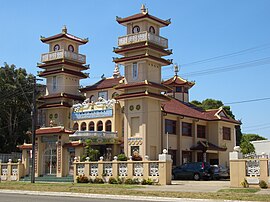| Main | Births etc |
|---|
| Wiley Park Sydney, | |||||||||||||
 King Georges Road, Lakemba | |||||||||||||
| Postcode: | 2195 | ||||||||||||
| Location: | 17 km (11 mi) south-west of Sydney CBD | ||||||||||||
| LGA: | City of Canterbury | ||||||||||||
| State District: | Lakemba | ||||||||||||
| Federal Division: | Watson | ||||||||||||
| |||||||||||||

Cao Dai Temple, King Georges Road

Wiley Park Station, King Georges Road

The Wiley Park amphitheatre

Ponds bordering the east side of Wiley Park
Wiley Park is a suburb in south-western Sydney, in the state of New South Wales, Australia. Wiley Park is located 17 kilometres south-west of the Sydney central business district in the City of Canterbury.
History[]
There is little documentary or archeological evidence of the activities of indigenous Australians in the suburb Wiley Park, although they lived in the Canterbury Municipality. The 20 acres (81,000 m2) now comprising Wiley Park was initially part of 60 acres (240,000 m2) of land granted to Robert Wilkinson in 1832. It passed to the Wiley family in 1862.
Wiley Park is named after the reserve of 20 acres (81,000 m2) that was bequeathed in the will of Mr. J.V. Wiley in 1906 for a park and recreational ground for local residents. Wiley was a shoemaker who died unmarried and without children.
At the time the bequest caused some dissent with the local council but after much debate at a public meeting it was decided to accept the bequest. This park is bounded by King Georges Road, Canterbury Road, Clio Street and Edge Street.[1]
Commercial area[]
Wiley Park is a predominantly residential area, with both detached houses and a great many small apartment blocks constructed in the 1960s and 1970s. A small shopping strip is located on King Georges Road, near the railway station. The adjoining suburbs have a greater degree of commercial activity. The suburb is also close to the large Roselands shopping centre. Also on King Georges Road, south of the train station is an impressive Cao Dai Temple.
Schools[]
Wiley Park Public School (formerly the Years 3-6 part of Lakemba Public School until 1984) and Lakemba Public School are located on opposite sides of King Georges Road.
Lakemba Public School was established on its present site around 1913. It had a reputation for high academic standards, and an "opportuntity class" for Years 5 and 6 students in the region was located at the school for many years.
Although the area has a tradition of blue collar workers, Lakemba Public School has also produced a number of highly respected professionals. One prominent example is Vin Wallace QC, who was the Senior Crown Prosecutor in New South Wales in the 1950s.
Wiley Park Girls High School (established 1957) is also located here. Former NSW Ombudsman Irene Moss attended the school. The NSW Teachers Federation asserts that the school is currently understaffed. A boys high school (Punchbowl Boys' High) is located in the adjoin suburb of Punchbowl. It has often been described as "the toughest school in Australia".
Transport[]
Wiley Park railway station is on the Bankstown line of the CityRail network.
King Georges Road is a main road running through Wiley Park that starts as Wiley Avenue, to the north in Greenacre through to Beverly Hills in the south and beyond. Canterbury Road runs along the southern border of the suburb.
Parks and culture[]
Wiley Park, on the corner of King Georges and Canterbury roads currently has a recreational area over 2.5 km². It has a large pond, and houses the Wiley Park Bicentennial Amphitheatre where local events such as Carols in the Park at Christmas and Youth X Festival are held.
Until the 1980s, Wiley Park included a large velodrome that held events including Australian Championships and hosted concerts by a range of artists including Johnny O'Keefe. Cycling in the area was a popular sport, and a famous cycling store was operated by Jack Walsh in the adjoining suburb of Punchbowl for 50 years. Unfortunately the council allowed the velodrome to fall into disrepair and removed it without community consultation, replacing part of its area with an amphitheatre.
Population[]
Wiley Park inhabited largely by Anglo Celtic residents of a working-class background. The suburb was became an increasingly multicultural suburb from the late 1970s onwards, with many residents born overseas or having parents born overseas, from countries such as Lebanon, Vietnam, Italy, Greece, the Philippines and the Pacific Islands.
References[]
- ^ The Book of Sydney Suburbs, Compiled by Frances Pollon, Angus & Robertson Publishers, 1990, Published in Australia ISBN 0-207-14495-8, page 271
| ||||||||
| This page uses content from the English language Wikipedia. The original content was at Wiley Park, New South Wales. The list of authors can be seen in the page history. As with this Familypedia wiki, the content of Wikipedia is available under the Creative Commons License. |
